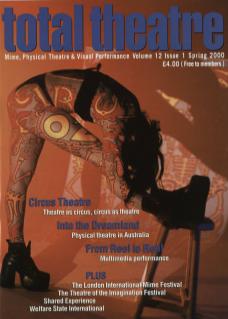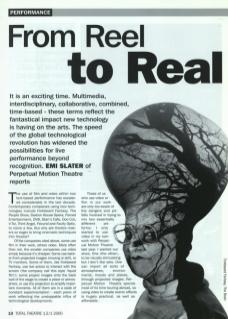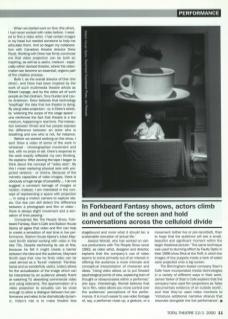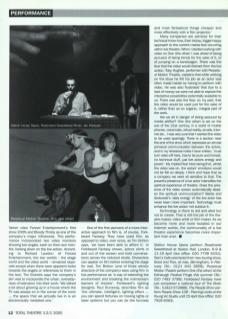The use of film and video within non text-based performance has escalated considerably in the last decade. Contemporary companies using new technologies include Forkbeard Fantasy, The People Show, Station House Opera, Forced Entertainment, DV8, Stan's Cafe, Doo-Cot, V-Tol, Third Angel, Fecund and Faulty Optic, to name a few. But why are theatre-makers so eager to bring cinematic techniques into theatre?
Of the companies cited above, some use film in their work, others video. More often than not, the smaller companies use video simply because it's cheaper. Some use back or front projected images (moving or still), or TV monitors. Some of them, like Forkbeard Fantasy, use live actors to interact with the screen (the company call this style ‘liquid film'); some project images onto the back wall of the stage to create a place or atmosphere, or use the projection to amplify important moments. All of them are in a state of constant experimentation – each piece of work reflecting the unstoppable influx of technological developments.
Those of us who use video or film in our work are only too aware of the dangers and pitfalls involved in trying to mix two essentially different artforms. I only started to use video in my own work with Perpetual Motion Theatre last year. I wanted our show, One (the other), to be visually stimulating but I don't like sets. One can import all sorts of atmospheres, environments, moods and places, through projected images. Perpetual Motion Theatre spends most of its time touring abroad, so using video to create scenic effects is hugely practical, as well as affordable.
When we started work on One (the other), I had never worked with video before. I needed to find a video artist. I had certain images in my head but needed someone to help me articulate them. And so began my collaboration with Canadian theatre director Drew Pautz. Working with Drew has firmly convinced me that video projection can be both an inspiring, as well as a useful, medium – especially within devised theatre, where the video-maker can become an essential, organic part of the creative process.
Both I, as the overall director of One (the other), and Drew had been inspired by the work of such multimedia theatre artists as Robert Lepage, and by the video art of such people as Dan Graham, Tony Oursler and Laurie Anderson. Drew believes that technology ‘leapfrogs’ the idea that live theatre is dying. By using video projection – or, in Drew's words, by 'widening the scope of the stage space' – one reinforces the fact that theatre is a live medium, happening in real time. The interaction between filmed and live people exposes the difference between an actor who is breathing and one who is not, for instance.
Before we started working on the show, I sent Drew a video of some of the work in rehearsal – choreographed movement and text, with no props or set. Drew's response to the work exactly reflected my own thinking. He explains: ‘After viewing the tape I began to think about the concept of "video sets". By this I mean replacing physical sets with projected versions – or visions. Because of the mimetic capacities of video images, there is obviously a huge range of possibility... I do not suggest a constant barrage of images or motion. Instead, I am interested in the concept of representing a space with projection... in using a motion camera to capture stasis. Our eye can still detect the difference between a photograph and film or video - there is always slight movement and a sensation of time passing.'
Companies like The People Show, Forkbeard Fantasy, Stan's Cafe and Station House Opera all agree that video and film can help to create a sensation of real time in live performance. Station House Opera's Julian Maynard Smith started working with video in the late 70s. Despite eschewing its use at first, because he felt it might create a barrier between the idea and the audience, Maynard Smith says that now he finds video can be used almost as a 'found' material: 'Familiar, banal and so wonderfully useful, [video] allows for the actualisation of the image which can be interpreted by an audience already fluent at watching TV, absorbing commercial video and using webcams. The approximation of a video projection to actuality can be close enough to allow a dialogue between live performance and video to be dramatically dynamic. Video's role is to make theatre less stage-bound and more what it should be: a sustainable evocation of actual life.’
Jessica Worrall, who has worked on various productions with The People Show since 1993, as video artist, designer and director, explains that the company's use of video seems to come primarily out of an interest in offering the audience a more intimate and conceptual interpretation of character and ideas. 'Using video allows us to put forward psychological points of view, explaining train of thought or idiosyncrasies within a performer,’ she says. Interestingly, Worrall believes that 'as in film, video allows you more control over the audiences' perceptions of the performance. It is much easier to use video footage of, say, a performer close-up, a gesture, or a movement (either live or pre-recorded), than to hope that the audience will see a small, beautiful and significant moment within the larger theatrical picture.' This same technique was used to stunning effect by Faulty Optic in their 1996 show Shot at the Troff, in which live images of tiny puppets inside a tank of water were projected onto a big screen.
In Forkbeard Fantasy shows, actors climb in and out of the screen and hold conversations across the celluloid divide
The Birmingham-based company Stan's Cafe have incorporated media technologies in a variety of different ways in their work. James Yarker of Stan's Cafe explains that the company have used film projections as ‘false documentary evidence of an outside world’, and that they've used video monitors to 'introduce additional narrative strands that resonate alongside the live performance'.
Yarker cites Forced Entertainment's first show 200% and Bloody Thirsty as one of the company's major influences. This performance incorporated two video monitors showing two angels, each on their own monitor, looking down on the live action. According to Richard Lowdon of Forced Entertainment, the two worlds – the stage world and the video world – remained separate except when there were apparent looks towards the angels or references to them in the text. Tim Etchells says the company's aim was to incorporate the urban, everydayness of television into their work: 'We talked a lot about growing up in a house where the TV was always on in the corner of the room... the space that we actually live in is an electronically mediated one.'
One of the first pioneers of a more interactive approach to film is, of course, Forkbeard Fantasy. They have used film, as opposed to video, ever since, as Tim Britton says, 'we have been able to afford it'. In Forkbeard Fantasy shows, actors climb in and out of the screen and hold conversations across the celluloid divide. Characters can appear on film before entering the stage for real. Tim Britton (one of three artistic directors of the company) sees using film in live performance as 'a way of extending the environment and breaking the mainstream barriers of theatre'. Forkbeard's lighting designer, Paul Dunaway, describes film as ‘the ultimate, intelligent, lighting effect... you can spend fortunes on moving lights or laser systems but you can do the funniest and most fantastical things cheaper and more effectively with a film projector’.
Many companies are admired for their technical know-how, their tricksy, trigger-happy approach to the current media-fest occurring within live theatre. When I started working with video on One (the other) I was afraid of being accused of being trendy for the sake of it, or of jumping on a bandwagon. There was the fear that the video would distract from the live action. Toby Hughes, performer with Perpetual Motion Theatre, explains that while working on the show he felt his job as an actor was often made harder by having to perform with video. He was also frustrated that due to a lack of money we were not able to explore the interactive possibilities potentially available to us. There was also the fear, on my part, that the video would be used just for the sake of it, rather than as an organic, integral part of the work.
Are we all in danger of being seduced by media artifice? One (the other) is set on the eve of the 21st century, in a world of mobile phones, voicemails, virtual reality, emails, Internet etc.. I was very sure that I wanted the video to be used sparingly. There is a section near the end of the show which expresses an almost primeval communication between the actors, and in my rehearsal notes I have written, 'must turn video off here, has to be pure and honest, no technical stuff, just live actors energy and power'. My implied fear here being that, whilst the video was on, the actors' emotions would not be felt so deeply. I think and hope that as a company we were all sensitive to that. The powerful presence of a live actor intensifies the spiritual experience of theatre. Does the presence of the video screen automatically deaden the spiritual communication? Barba and Grotowski's daily energy of the live actor has never been more important. Technology must enhance the live action not subdue it.
Technology is there to aid and abet but not to create. That is still the job of the theatre-maker, video-artist or film-maker. As we become more and more isolated in our Internet worlds, the communality of a live theatre experience becomes more important than ever.
Station House Opera perform Roadmetal Sweetbread at Hoxton Hall, London, 6-9 & 11-16 April; Stan's Cafe premiered their new touring show, Good and True, at mac, Birmingham, in February; Perpetual Motion Theatre perform One (the other) at the Edinburgh Festival Fringe this summer; Forkbeard Fantasy have just completed a national tour of The Brain; The People Show perform People Show 108 - Flaming Locks at the Young Vic Studio until 15 April.



